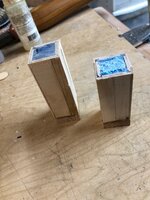I need to drill a 37/64 hole in a 3/4 blank, not much room for error. The blank is coral cast in resin, very hard and very brittle. I think I will need to wrap it in fabric and soak in CA to hold it together while drilling. Maybe I should suspend it in a bigger mold and pour clear resin around it to hold it together when drilling. Should I start with a small hole and work my way up to the full size?
I've been looking for granite/marble/glass bits that come in obscure sizes like 37/64, not finding anything. Maybe I could use a 9/16 bit and then file it out a little larger with a rat tail file, but still would need to find a 9/16 bit to drill stone. I'm looking for ideas
I've been looking for granite/marble/glass bits that come in obscure sizes like 37/64, not finding anything. Maybe I could use a 9/16 bit and then file it out a little larger with a rat tail file, but still would need to find a 9/16 bit to drill stone. I'm looking for ideas

